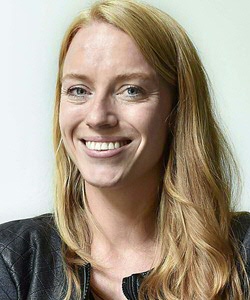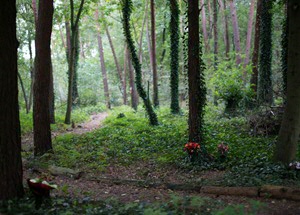Who will have their remains dissolved?

Natural burial grounds are on the rise in the Netherlands. But there are other ways in which to entrust yourself to eternity in an environmentally friendly manner. Brenda Mathijssen has recently been awarded a Veni grant by the Dutch Research Council (NWO) for her research into green funeral practices. Whether we are considering a traditional funeral or the recently approved dissolving of bodily matter in an alkaline solution: sustainability is earning its place in the funeral business.
Natural burials are slowly gaining in popularity. Although only a small number of people – approximately 1,100 – chose a natural burial in 2019, this number has doubled compared to five years before that. But the ideas behind new funerary practices are more far-reaching than that: they are also influencing ‘regular’ cemeteries and funeral practices, as well as the way in which we deal with death, grief and our deceased. Dr Brenda Mathijssen, Assistant Professor of Psychology, Culture and Religion at the Faculty of Theology and Religious Studies, is discovering the world behind green funeral practices.
What is it that you want to research?
Our lifestyle is mirrored in the way that we deal with death. As such, practices surrounding death can teach us about the norms, values and worldviews of people. I am therefore researching the way in which people are using natural burial grounds to gain insight into their worldviews. One aspect I am taking a look at is the cultural significance of green funerary practices, but I am also researching what these practices reveal about people’s fundamental values. For example: what do green funerary practices show us about the relationship between humans and nature? How does a subject like climate change influence the meaning-making processes that people undergo?
What is your approach to this research?
First, I will properly map the green natural burial grounds of the Netherlands. Which sites qualify as natural, and which do not? Who is using them, and who is not? Additionally, I will interview the people who do in fact use these places: relatives of the deceased, future inhabitants, volunteers, owners. I would like to hold these discussions at the burial grounds themselves, via so-called walking interviews, in an effort to directly link interviewees’ experiences and ideas to these green landscapes of the dead.
That’s some hands-on research!
It is! I am collaborating with several organizations, such as Natuurbegraven Nederland and Stichting Greenleave, the latter of which is working to make the funeral business more sustainable. I am also involving local organizations that are working on sustainability, particularly sustainability surrounding death. Moreover, I would like to mediate my results to a wider audience, via podcasts for instance. I am also planning to create a card game that should ease conversations surrounding death and people’s funerary wishes.

Could you provide some examples of green funerary practices?
Green funerary practices go further than just burial at natural sites, for example in consideration of the preservation or creation of nature. They encompass alkaline hydrolysis as well – which is also referred to as ‘resomation’. Alkaline hydrolysis is a process in which bodily matter is dissolved in a heated liquid mixed with the highly corrosive potassium hydroxide. The minister is currently drafting a bill aimed at legalizing this practice, based on advice given by the Health Council, which I was also involved with. There is also the practice of human composting, however, techniques involving this have been insufficiently researched as of yet. Experiments in this field are being carried out in the United States. But we can also consider the sustainability of funeral business operations: consider, for example, electric ovens or hearses, or the use of biodegradable clothing.
Are you currently entirely uninformed of the people whose funerals you are researching?
Research from England has shown that most people who choose a natural burial are lovers of nature, who are not or not as much concerned about sustainability. I am very curious to find out whether that is also the case in the Netherlands. It is my impression that natural burials mainly appeal to secular, moderately Christian or spiritual Dutch people from the middle class. It Is often presented as ‘natural’ and thus it is seen as value-free and inclusive. I do not believe that this is justified. Natural burial grounds offer, for example, an eternal resting place, something that can be found practically nowhere else. It would make for an interesting option for Muslims, and yet it seems to be rather inaccessible to this demographic. Why is that? I want to find out in what way sustainable funerary practices reflect diversity within societies and shed light on the norms and values that accompany such practices.

Have sustainable burials not always been part of our own culture?
In some ways, yes: burial and cremation have been practised for a long time already. What is interesting is that these ‘new’ sustainable practices seem to be spreading mainly from the US and the UK. In the US, we commonly see coffins made from lead, concrete burial chambers and embalming. Due to the latter, approximately 20 million liters of formaldehyde disappears into the ground on a yearly basis. Such a situation gives cause for big steps to be taken in terms of sustainability. Considering this, our funerary practices here are relatively green as they are: it is mandatory to use a biodegradable coffin or shroud, and embalming is prohibited. In terms of a life cycle assessment, it is questionable as to what extent we would benefit from sustainable funerals in the Netherlands. But the emphasis on sustainability, care for the planet and continuity seems to be much more closely connected to questions surrounding culture and identity than to sustainability itself.
You are conducting a lot of research into funerary rites. In what way are they affected by the coronavirus pandemic?
People are not always able to be present at the moment of death. Many are terrified of dying alone, and such an event can give relatives feelings of helplessness. Not to mention social distancing, or attending online. It is exactly during such emotional moments that we want to hold each other, and that is currently not possible. Stories of how difficult this is, in practice, have reached my ears. At the same time, it pleases me to see in what ways professionals are trying to satisfy people’s needs: for example, by organizing smaller funerals, accompanied by condolences, to provide some form of intimacy. Moreover, the coronavirus pandemic is limiting repatriations. This has an enormous influence on recent migrants and minorities that would have wanted to be buried in Turkey or Morocco, for example. In response to this, new Islamic burial sites have come into existence, and Rotterdam, for instance, granted eternal burial rest to Dutch Muslims as from March this year.
More information
- Brenda Mathijsen
- Stories of the dead (article)
| Last modified: | 02 December 2020 09.38 a.m. |
More news
-
05 March 2025
Women in Science
The UG celebrates International Women’s Day with a special photo series: Women in Science.
-
10 February 2025
Project GRACE: An ENLIGHT ETN Grant Winner
We are happy to announce that the project GRACE, with Julia Martínez-Ariño as the main coordinator, is one of the projects selected for the ENLIGHT 2024 Call. Congratulations to the GRACE team.
